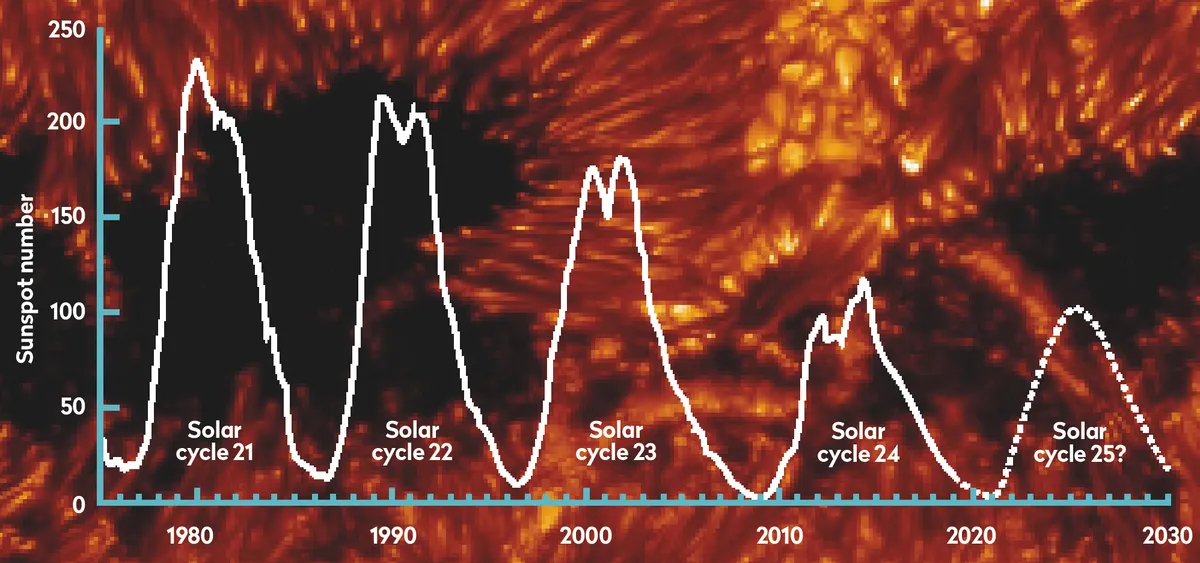The solar cycle is a quasi-periodic variation in the magnetic activity of the Sun, most evident in the fluctuating number of Sunspots and the frequency of solar flares and coronal mass ejections (CMEs). The basic sunspot cycle averages about 11 years, while the solar magnetic polarity completes a 22‑year Hale cycle with alternating hemispheric leading polarities, a pattern established by early 20th‑century magnetograph observations. Authoritative summaries of the cycle’s duration, discovery, and polarity reversal include Encyclopaedia Britannica and modern reviews. Britannica;
Living Reviews in Solar Physics.
Definition, indices, and data series
- –The primary operational index is the International Sunspot Number (ISN), curated by the World Data Center SILSO at the Royal Observatory of Belgium. The ISN is computed from a global network using the Wolf formula R = k(10·g + s), where g is the number of sunspot groups, s the number of individual spots, and k an observer normalization factor; SILSO provides daily, monthly, and 13‑month smoothed series and governs versioning (V1.0/V2.0).
SILSO – About;
SILSO – Daily total sunspot number;
ROB/SILSO Sunspot Number V2.0.
- –The 10.7‑cm (2800 MHz) solar radio flux, measured in Canada since 1947 at the Dominion Radio Astrophysical Observatory (DRAO), is a robust ground‑based proxy that correlates well with sunspot number and solar EUV/UV emissions used in ionospheric and thermospheric modeling.
NOAA SWPC – F10.7 cm Radio Emissions;
National Research Council Canada – Solar weather monitoring.
Historical discovery and nomenclature
- –Regular telescopic sunspot observations began in the early 17th century; the 11‑year cycle was identified by Samuel Heinrich Schwabe in 1843, and the modern numbering of cycles—beginning with Cycle 1 in 1755—was systematized by Rudolf Wolf in Zürich. The magnetic nature and hemispheric polarity rules (Hale’s law) were established in the early 1900s, showing that a complete magnetic cycle spans about 22 years.
Britannica;
Britannica – Sunspot.
- –Extended intervals of suppressed sunspot activity are termed grand minima; the best‑known example is the Maunder Minimum (~1645–1715), documented historically and via cosmogenic isotopes. Long‑term reconstructions from ¹⁰Be and ¹⁴C reveal multi‑centennial variability and episodes of grand minima and maxima.
Britannica;
Usoskin, Living Reviews in Solar Physics.
Observed characteristics of the cycle
- –Sunspot latitudes migrate equatorward through the cycle, producing the “butterfly diagram” (Spörer’s law), while bipolar groups exhibit systematic tilts (Joy’s law). Cycle amplitude and length vary (roughly 9–14 years), and many cycles display a double‑peaked maximum (Gnevyshev gap).
Living Reviews in Solar Physics;
Britannica – Sunspot.
- –Beyond sunspots, global activity changes are tracked through flares, CMEs, coronal holes, irradiance, and heliospheric modulation of galactic cosmic rays, which anti‑correlate with sunspot activity and are observed by neutron monitors and cosmogenic proxies.
Usoskin, Living Reviews in Solar Physics;
Living Reviews in Solar Physics.
Physical origin
- –The solar cycle is explained by hydromagnetic Dynamo theory: differential rotation, convection, and meridional flow couple to convert poloidal and toroidal magnetic fields. In Babcock–Leighton‑type dynamos, the decay and dispersal of tilted active regions regenerate the poloidal field; the polar field at solar minimum serves as a key precursor of the next cycle’s amplitude in many models.
Charbonneau, Living Reviews in Solar Physics;
Hathaway, Living Reviews in Solar Physics.
- –Modeling indicates that the system’s “memory” for amplitude prediction is limited, often to about one cycle, consistent with stochastic emergence and transport effects.
Charbonneau, Living Reviews in Solar Physics;
Kumar et al., 2021 (arXiv preprint).
Current cycle (Solar Cycle 25)
- –Solar Cycle 25 began at the minimum dated to December 2019 (13‑month smoothed sunspot number 1.8), as established by the international panel co‑chaired by NOAA and NASA and by the WDC–SILSO analysis.
NOAA/NWS: “Hello Solar Cycle 25”;
Royal Observatory of Belgium – minimum confirmed.
- –In December 2023, NOAA’s Space Weather Prediction Center released an updated, continuously refreshed forecast indicating a quicker, stronger rise than the original 2019 panel forecast, with the maximum window shifted into 2024.
NOAA SWPC news release;
SWPC Solar Cycle Progression (Testbed).
- –NASA and NOAA announced on October 15, 2024 that the Sun had entered its solar‑maximum phase for this cycle, with elevated activity expected to persist around the peak period.
NASA Science – “Sun Reaches Maximum Phase”;
NOAA SWPC Solar Cycle Progression.
- –Solar Cycle 25 has produced numerous major events, including an extreme (G5) geomagnetic storm on May 10–12, 2024 driven by multiple CMEs from AR3664, prompting broad auroral displays and documented impacts to navigation and communications.
USGS Geomagnetism – May 10, 2024;
NOAA SWPC – G4/G5 Watches and notices;
NOAA repository (GOLD study).
Space weather impacts
- –Heightened solar activity modulates the heliosphere, increasing risks from radio blackouts (X‑ray flares), radiation storms (solar energetic particles), and geomagnetic storms (CME‑driven), which can disturb HF and satellite communications, degrade GNSS accuracy, increase satellite drag, and induce currents in long conductors such as power grids and pipelines.
NOAA SWPC – Geomagnetic Storms;
NOAA SWPC – Impacts overview;
NASA News – Hazards of Severe Space Weather.
Observation and study
- –Modern cycle research integrates synoptic magnetograms, helioseismology, and multi‑mission datasets. NASA’s Parker Solar Probe samples the inner heliosphere and solar corona, reaching perihelia of ~3.8 million miles and speeds ~430,000 mph to probe coronal heating, solar wind origins, and particle acceleration. ESA’s Solar Orbiter provides high‑latitude imaging and in‑situ measurements to illuminate polar fields and flux transport crucial to cycle reversals.
NASA – Parker Solar Probe mission page;
NASA – Closest pass news (Dec 2024);
ESA – Solar Orbiter.
Related concepts and events
- –The cycle’s variability frames key historical and geophysical episodes, notably the Carrington Event of 1859, an extreme geomagnetic storm attributed to a fast CME, and the spectrum of grand minima/maxima evidenced in radionuclide archives.
Living Reviews in Solar Physics;
Britannica.
